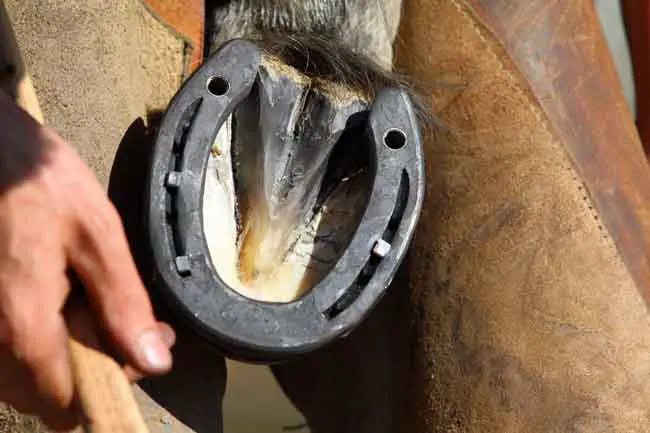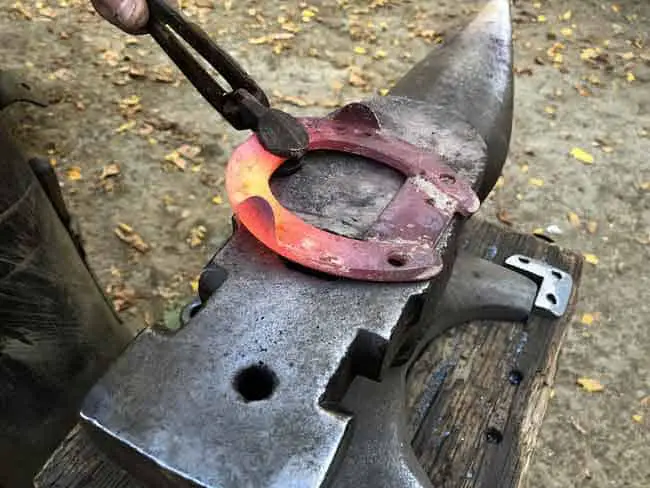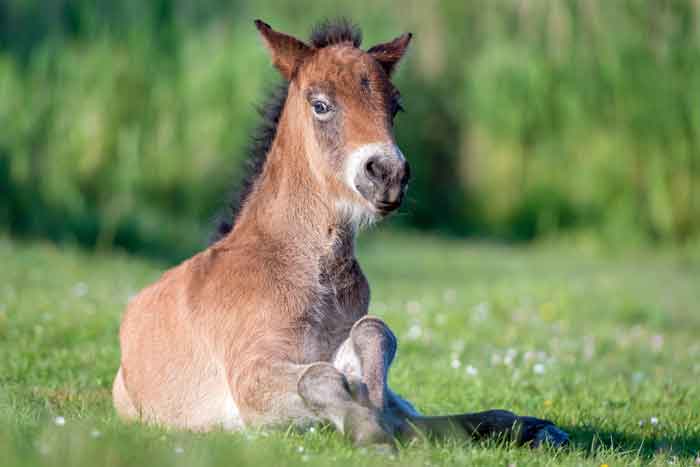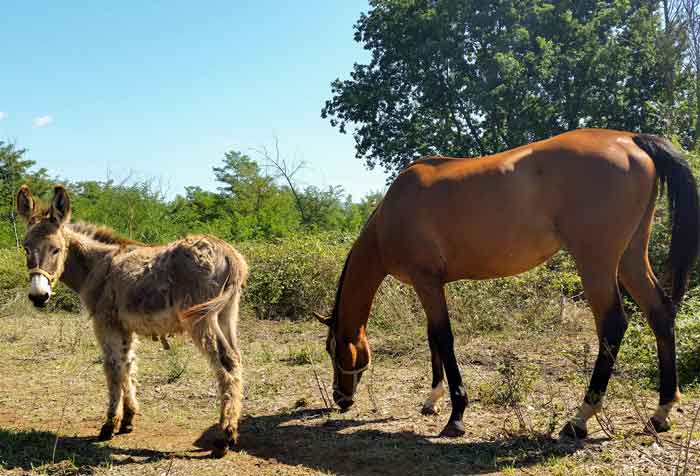It seems harsh to mount a metal horseshoe under the hoof with nails. How does it feel for the horse to have it done?
Do The Horseshoes Hurt The Horse?
When done properly, it doesn’t hurt the horse to have the horseshoes mounted. The hoof is connected to the skin and flesh but the hoof itself can be compared to the fingernails of humans. As long as the nails are not inserted too deeply the horse will not feel pain.
Let’s take a closer look at how you do it properly.
There are some very important factors to remember before you mess around with the horseshoe on the horse.
Table of Contents
How Much Can The Horse Feel When Mounting Horseshoes?

As we mentioned above, the hoof of the horse is quite similar to the fingernails of humans. This also means that the animal will feel some sensations when the horseshoe is nailed unto the hoof.
But this amount of (possible) discomfort is very little compared to the pain the horse might encounter if it doesn’t have the horseshoes while riding on hard surfaces with you on top.
Veterinarians have compared the procedure to the pain humans would feel if you were to tap a screw or nail into your fingernail. It shouldn’t hurt at all but feel more like the weird sensations of filing a nail.
In other words, the horse will be just fine.
But it is very important that it is done by someone with experience. This is not something for amateurs to mess around with. You should never try to mount horseshoes yourself. If you manage to drive the nails too deep you will cause immense pain unto the poor creature.
So make sure it is done properly by a farrier with experience. You can always ask how many times the person has done it before just to make sure that he/she has a lot of experience.
What Exactly Happens When Mounting The Horseshoes?
The farrier is the person who works with cleaning, maintaining, and mounting horseshoes on the hoof of the horse. Here’s how he/she goes about mounting a horseshoe:
- First, the farrier will clean the hoofs. This is absolutely not painful to the horse in any way. The farrier will scrape off any dirt and unevenness under the hoof.
- Now the old horseshoe can be removed. It’s a painless experience where the
- Now the hoofs are being filed and cut if they are too long.
- The hoof is now ready for the horseshoe. The farrier will place the horseshoe unto the hoof and insert the nails.
- Finally, the nails are filed off so they don’t stick out under the hooves.
This is normally a painless procedure. There are exceptions though as we will look in a second.
The vet will do this for all four hoofs and the horse is ready to come home with you with new shoes on. It will not be much more likely to have a good time every time you ride even if you primarily ride on concrete or roads. This can otherwise be pretty painful in the long run if the horse is not wearing horseshoes.
How long time does it take to mount the horseshoes?
It normally takes up to five minutes for each hoof. This can be a long time for that animal to stand unfree legs and this is also part of why you need to train the horse for this from an early age.
If the animal is feeling discomfort during to process it can easily lift the food back on the floor. In this case, the farrier will typically just take a break and pet the animal for a while.
It’s normally harder for the farrier to do this process than for the animal.
This is because the work position isn’t very comfortable for the farrier. But it’s definitely necessary in order for the horse to have healthy feet.
3 Things That Can Cause Pain When Shoeing The Horse
As with all rules, there are also exceptions.
Let’s take a look at what can go wrong and how it will impact the horse. We will also look at what you can do to avoid these situations as they can be quite painful for the horse.
1) When the horse has bruises from not wearing horseshoes
If you have ridden the horse on hard surfaces without horseshoes the animal may have gotten bruises under the hooves.
When the farrier will clean the hooves and mount the horseshoes this can be a hurtful process. This is because the hoof is sore and possibly swollen around the hoof.
This can probably be compared to when you have inflammation at the side of your nail and you need to clean it and you start tapping the nail.
This is not pleasant to the horse and you can avoid it by visiting the farrier in due time so the horse is not ridden without horseshoes.
2) When an unexperienced farrier drives the nail too deep
If the farrier (or someone without experience) hasn’t got much experience he/she might accidentally drive the nail too deep into the hoof.
This can be very painful and it is best compared to driving and nail into your skin. The flesh underneath the hooves (sensitive laminae) is very sensitive and should not be messed with during the procedure.
This is called a “hot nail” and when it goes wrong you will have an instant reaction from the horse. It would let you know immediately what is going on. Similar to your own reaction if someone drives a nail through your fingernail and into the sensitive skin.
Any farrier with experience knows exactly how to work around this so it doesn’t happen. This is exactly what the farrier is trained to do and they will very rarely miss.
3) When the horseshoe doesn’t fit
If you mount horseshoes that are either too small or too big it will cause trouble and possibly pain for the horse.
You also need to make sure the shoe is shaped correctly. The hooves are shaped a little differently for each horse and you need to pay careful attention to the shape and form when you prepare the horseshoe.
If the horseshoe doesn’t fit it might end up cracking the hoof and this can cause pain for the animal if it’s not treated quickly.
4) Discomfort from the loud hammering noises

Some horses do not handle the loud noises from the hammer very well. They might get scared or frightened from the loud sounds it makes when the farrier is correcting the shoes.
Remember, that the farrier will first measure the horseshoe a couple of times while hammering it into the correct shape. Then it can be mounted unto the hoof.
The best thing you can do here is to stay close to your horse and make sure it knows exactly where you are during the process. Remember that horses have blind spots behind them and if you are standing directly in front of their nose.
The farrier might also let you hold the animal during the process.
You can also bring some of the horses’ favorite snacks like apples or carrots. This might help calm down the animal and take the focus away from the loud noises and the smell from the smoke.
5) Don’t ride too hard the first day after shoeing
You should take a day or two for the horse to get used to the shoes. This is also to make sure they are mounted correctly. So don’t take him for a very long and hard ride just after mounting the shoe.
If something is not mounted correctly or something is itching the horse you need to take him back to the farrier to fix and fit the horseshoe correctly.
This can also happen if the hoof was hurt or filed to close but normally everything will be just fine. Just take it easy the first couple of days, especially if this is the first time the horse has gotten horseshoes mounted.
How Often Should You Consult The Farrier?
You should take the horse to the farrier every month or at least every second month. But this depends largely on how much you’re riding the horse and where you are riding.
If you are riding in on hard surfaces several days of the week you need to do it monthly.
Otherwise, you might be able to wait up to eight weeks before you visited the farrier with the horse. This is to ensure that the farrier can catch any irregularities in time. Most of the time little cracks can be fixed when they are filed down and treated quickly.
Otherwise, you might end up with a limping horse that you cannot ride. And that can also be painful for the poor horse.
Should I Even Use Horseshoes?
This is a very old debate. There are pros and cons on each side but generally, everybody in the horse world would recommend using horseshoes on your horse.
You need horseshoes in order to protect the hooves. It can actually be compared to yourself going bare feet. Or maybe not completely barefoot (as the hooves are like fingernails) but more like wearing slippers.
Whenever you encounter something pointy (or if the hooves are worn down) that sharp thing might end up in the wrong place and that will hurt the horse much more than you think.
If you do ride the horse on hard surfaces without horseshoes the hooves might simply crack. This can be very painful for the animal and that’s one of the main reasons why you should always shoe your horse.
If you are considering riding the horse without horseshoes you need to make sure you’re not riding on hard surfaces too often. Whenever you are riding on concrete or asphalt you will wear down the hooves. It’s better to ride on grass and fields if you insist on riding the horse barefoot.
Here are the factors that determine whether the horse need horseshoes:
- If you ride the horse on hard surfaces it will need horseshoes
- If you work the horse with a heavy workload you also need to put on horseshoes.
- If the horse has any irregularities in the hooves it might benefit greatly from horseshoes as well.
- If you ride it often and hard he/she will need horseshoes.







